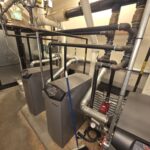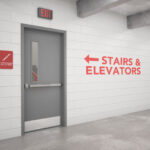I read an article this morning about a 3-year-old boy who eloped from his preschool in Bangor, Maine (Bangor Daily News: Toddler returned to child care center after escape through unlocked fire door). The teacher saw him go through the exterior door while she was changing another child’s diaper. By the time the teacher had placed that child on the floor and chased after the child who had eloped, a tragedy could have occurred as there was a busy street nearby. I think it’s interesting that the poll question accompanying the article shows that 79% of the respondents would not allow child care centers to lock their egress doors, while 21% would allow those doors to be locked. (My favorite line of the article: “The boy was not injured and afterward took a nap, his father, James Higgins of Bangor, said Monday.” 🙂 )
 Elopement of young children and students with special needs is something many schools struggle with. Because most doors are required to unlatch with one operation, and the International Building Code (IBC) does not currently allow delayed egress locks to be used in Educational (or Assembly or High Hazard) occupancies, the most restrictive hardware that would be compliant with the IBC is an exit alarm. In the situation described in the article, an alarm wouldn’t have helped unless it momentarily scared or confused the child enough to slow him down.
Elopement of young children and students with special needs is something many schools struggle with. Because most doors are required to unlatch with one operation, and the International Building Code (IBC) does not currently allow delayed egress locks to be used in Educational (or Assembly or High Hazard) occupancies, the most restrictive hardware that would be compliant with the IBC is an exit alarm. In the situation described in the article, an alarm wouldn’t have helped unless it momentarily scared or confused the child enough to slow him down.
In order to address this issue and give schools another option for deterring egress, the BHMA Codes & Government Affairs Committee and the Building Code Action Committee both submitted code change proposals for the 2018 IBC which would allow delayed egress locks to be used in Educational occupancies if the building is equipped throughout with an automatic sprinkler system or approved automatic smoke or heat detection system. The original proposals would have restricted the use of delayed egress locks in schools to spaces with an occupant load of 10 people or less, which was an attempt to limit their use to doors serving classrooms with a small number of students.
Proposal E68-15 was later modified to remove the 10-occupant limit, was approved as modified by the ICC committee, and will be incorporated into the 2018 edition of the IBC; the 10-occupant limit was later changed to 50 occupants. In that edition, classrooms in Educational occupancies with an occupant load of less than 50 people will be listed as one of the use groups where delayed egress locks can be used (refer to page 861 of this document for more information). Technically, the 2018 edition must be adopted in a school’s jurisdiction before this change will go into effect, but the documentation associated with the upcoming change may be useful for discussions with the Authority Having Jurisdiction, if a school would like to request permission from the AHJ to use delayed egress locks. FYI – NFPA 101-The Life Safety Code currently allows the use of delayed egress locks in Educational and Day Care occupancies without a restriction on occupant load.
UPDATE: Refer to this post about related changes to the 2018 IBC.
Image: Shutterstock.com/Shavarina
You need to login or register to bookmark/favorite this content.





Could delayed egress or a fail-safe maglock be used if it is tied into the fire alarm to release upon an alarm?
If a standard mag-lock is used, the model codes would require it to be released on the egress side – either by a sensor + push button + fire alarm + power failure, or by door-mounted hardware + power failure. Neither of these applications would stop elopement.
The current and past editions of the IBC do not allow delayed egress locks in schools, but the 2018 edition will.
– Lori
Build a fence, silly rabbit.
That’s what the fire marshal said. 🙂
https://wabi.tv/2016/07/12/fire-inspector-reacts-to-incident-at-bangor-daycare/
– Lori
Would it be practical to have a lock which allowed delayed egress by anyone with a single action and no special knowledge or effort, but instant egress with knowledge or effort?
Hi John –
If you’re thinking about a delayed egress lock, the code change would allow that (in the future). Another type of lock which delays egress for people who don’t know how to use it would likely not be acceptable.
– Lori
Working at Los Angeles Unified School District, we get frequent requests to secure fire exits to prevent elopement (though usually at the high school level). Standard policy is no locking egress, no special knowledge to exit. Even children need to be able to get out unassisted in an emergency. The root problem is that people want a LOCK to fix a SUPERVISION problem. The only correct configuration is free egress for everyone in an emergency, and adult supervision keeping kids in school.
I just completed an assessment report for a an elementary school for a district-who-shall-not-be-named. I included a bit about their playground fences which had openings that could pose a security risk. The comment from the district was that this was a standard practice to allow the community to use the facilities. I was kind of taken aback…
Hi Logan –
Our elementary school in Massachusetts had openings in the fence until a little over a year ago, but even now someone can walk onto the playground from the front or side of the school.
– Lori
I believe that when we have SPECIAL NEEDS students (in California those with an IEP designation) that the classroom may fall into a Institutional occupancy. Much like a memory care center, mental health hospital, etc. We have made this case and gotten the AHJ to at least consider it.
Hi Glenn –
I think that’s a viable alternative as long as the building is sprinklered, the AHJ approves the controlled egress hardware, and the operation of the door is part of the emergency plan and drills.
– Lori